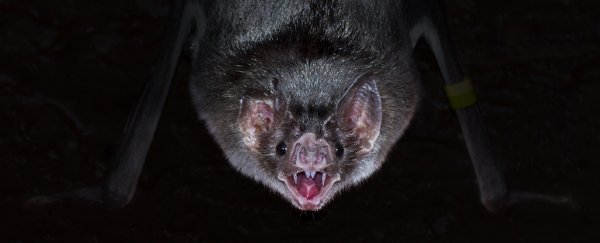Vampire bats have long been suspected of passing on rabies to humans and livestock in Latin America, but up until now solid statistics have been hard to come by. A new study gives us some idea of the problem – and it's not looking good.
The study, carried out in Peru, estimates that more than 500 heads of cattle each year are killed by rabies passed on by the common vampire bat, at a cost of up to US$300,000 in lost livestock and rabies vaccination costs for local farmers.
However, the international team researchers suggests that the number of deaths and the associated costs can be lowered through some simple preventative measures, like earlier vaccinations and more accurate reporting of rabies outbreaks.
"This estimate, at least four times higher than official reports, is essential in planning and implementing cost-effective measures to prevent and control the disease, which mainly affects low-income, small-scale farmers," say the researchers in their published paper.
"Our results further suggest that increasing the risk perception of communities that are far from reporting offices could both increase reporting and reduce cattle losses by encouraging preventative vaccination in high risk areas."
Digging into 11 years of reports of vampire bat rabies (VBR), and interviewing 400 farmers across 40 communities in the region, the researchers estimate that there are around 4.6 incidents of VBR for every case that's officially reported and logged.
That would put the yearly cattle death tally somewhere between 505 and 724, at a cost to farmers of at least US$120,000 before vaccination costs are added in.
For impoverished farming communities that rely on their livestock, that's a big problem: the loss of a single cow to VBR, at an estimated cost of around US$241, is the equivalent of one month's income for the farmers rearing them.
"Livestock are considered like bank accounts," lead researcher Julio Benavides, from the University of Glasgow in the UK, told Sophie Hares at Reuters.
"So losing even one animal keeps [farmers] under the poverty line. For the individual farmer it's a huge loss."
Although it was already clear that vampire bats made up the largest reservoir of rabies in Latin America, being able to pin such a precise number on the scale of the problem is rare.
The bats swoop down at night to bite cattle, and even if the animals survive, bleeding, lower milk production, and other health issues can cause problems. These night prowlers will even attack people in some situations.
There is some hope though. The researchers say improved vaccination programmes could make a dint in that figure, as could raising awareness – many farmers won't report an incident of rabies because they're unaware of the risk to human health.
And as we've already noted, distance to official reporting offices is a problem for farmers too, another area where improvements can be made.
The researchers found a great deal of variation across the communities they visited. The reporting of rabies infections, for example, ranged from 0 percent to 100 percent depending on the area, averaging out at 38 percent.
That's a problem because getting accurate information is crucial in working out how the vampire bats and the rabies infections are spreading.
Meanwhile, coverage from preventative vaccinations also varied from 0 percent to 100 percent depending on the specific community, with an average of 59 percent. Get those numbers higher, and we might start seeing a reduction in the rabies threat posed by Peruvian vampire bats.
Even simple measures like introducing community radios to raise awareness of the problem could help tackle the issue, the researchers say.
And ultimately, the team hopes its efforts in pulling together these statistics can help other researchers trying to get figures on other diseases in other parts of the world.
"More broadly, this work highlights how variation in disease reporting can influence estimates of disease burden, which will be important to consider when extrapolating burden estimates from community-based studies across larger spatial scales," conclude the researchers.
The findings have been published in PLOS Neglected Tropical Diseases.
